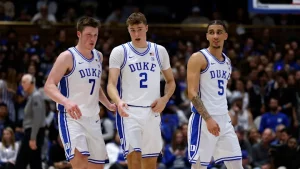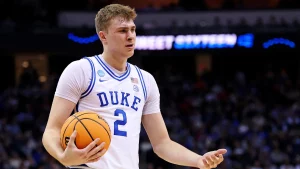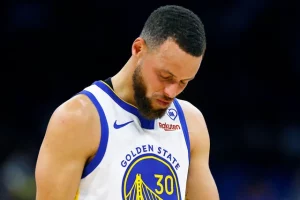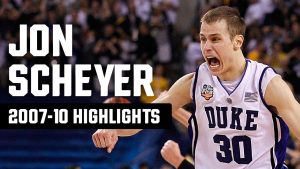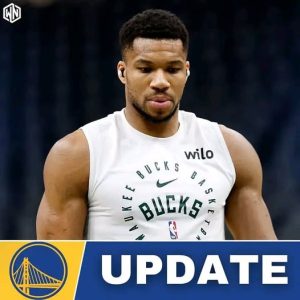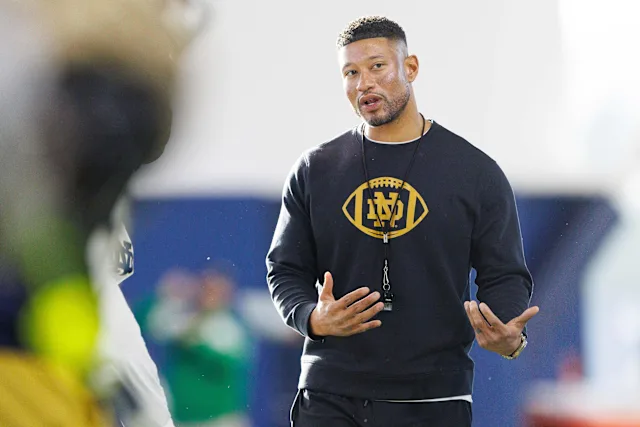
Following an electric spring camp, high-impact transfer acquisitions, and a coaching staff that has quietly sculpted one of the deepest rosters in college football, Notre Dame landed at No. 5 in The Athletic’s Post-Spring Top 25 rankings. It’s a sign of growing respect for head coach Marcus Freeman, who is entering his third season in South Bend with a sharper edge and national expectations that haven’t felt this real since the Brian Kelly playoff years.
But unlike past seasons where optimism often came with asterisks—whether due to quarterback inconsistency, talent depth, or schedule concerns—this Notre Dame team has no such disclaimers. The Athletic’s ranking is more than preseason praise; it’s a reflection of a program that’s ready to make the jump from perennial top-15 squad to true national contender.
Let’s unpack why Notre Dame earned this spot, how they stack up against the nation’s elite, and what the ranking says about the current state—and future—of Irish football.
When The Athletic released its Post-Spring Top 25, the Top 5 included a few expected names:
-
Georgia
-
Ohio State
-
Oregon
-
Texas
-
Notre Dame
That’s right. Ahead of Alabama. Ahead of Michigan. Ahead of Florida State, Penn State, LSU, and USC. All programs that have recruited well, spent heavily in NIL, and occupied the national spotlight over the past two years.
So why Notre Dame?
According to The Athletic, it comes down to three things:
-
Elite quarterback play with Duke transfer Riley Leonard
-
A reloaded and aggressive defense
-
An offensive line and receiving corps that are finally complementary, not conflicting
In short, this is Freeman’s best team yet—balanced, physical, and fast. And perhaps for the first time in a decade, the Irish may have more than just a puncher’s chance in a College Football Playoff game.
Let’s start with the most important position on the field.
After years of questions at quarterback, Notre Dame finally secured a proven, dual-threat signal caller in Riley Leonard. A former star at Duke, Leonard brings toughness, maturity, and mobility—exactly what the Irish lacked in key moments last year. When healthy, he’s a top-10 quarterback nationally and has already drawn comparisons to former Irish greats like Ian Book—but with a better arm and a higher NFL ceiling.
The Athletic cited Leonard’s poise, leadership, and ability to extend plays as “transformational” for an offense that too often stalled in crunch time. Behind a strong offensive line and with new weapons at his disposal, Leonard might just be the missing piece.
If he stays healthy—and that’s still a concern after last year’s injury-plagued campaign—Notre Dame has a field general capable of winning in Athens, Tuscaloosa, or Pasadena.
Leonard’s skill set is amplified by the arrival of new offensive coordinator Mike Denbrock, who returns to South Bend after a wildly successful stint at LSU, where he helped Joe Burrow and Jayden Daniels flourish. Denbrock is no stranger to Notre Dame fans, but this time he comes armed with SEC-tested schemes and a better understanding of how to unlock tempo and mismatches.
Expect more spread, more movement, and more vertical shots.
Denbrock has already made it clear: he intends to modernize the Irish offense without abandoning the physical identity that has long defined the program. That means Leonard won’t just be managing games; he’ll be making plays—on the ground and through the air.
And with Denbrock pulling the strings, Notre Dame may finally be able to go toe-to-toe with the offensive firepower of Georgia or Texas.
While the offense has received much of the offseason buzz, Notre Dame’s defense might be its greatest strength.
Anchored by future first-rounder Howard Cross III and freakish edge rusher Junior Tuihalamaka, the Irish front seven is loaded with speed, depth, and NFL talent. The Athletic praised Notre Dame’s “disruptive and disciplined” defensive identity, noting that the unit finished among the top 10 in most advanced metrics last season—and looks even stronger this spring.
Add in star linebacker Jack Kiser, who’s returned for a fifth season, and a secondary headlined by veteran cornerback Benjamin Morrison, and this defense has very few holes.
Defensive coordinator Al Golden has quietly built one of the most complete units in the country, and he’s not afraid to be aggressive. That’s key in a season where Notre Dame faces offenses like Texas A&M, USC, and Florida State.
One major reason Notre Dame landed at No. 5 in The Athletic’s rankings? They dominated the transfer portal—and developed their young core.
Key additions include:
-
WR Kris Mitchell (FIU): A deep-ball threat with elite speed who impressed during the spring game.
-
CB Beanie Bishop (West Virginia): A veteran corner who adds physicality and lockdown potential opposite Morrison.
-
RB Jabari Small (Tennessee): A tough, SEC-tested runner who will share duties with rising star Jeremiyah Love.
These pieces aren’t just depth—they’re difference-makers.
Combine that with breakout freshmen like receiver Jordan Faison, linebacker Kyngstonn Viliamu-Asa, and safety Adon Shuler, and you have a roster that’s as loaded as it’s been in the modern era.
Recruiting is finally catching up to expectation in South Bend, and Freeman’s fingerprints are all over this culture.
Let’s be honest: when Marcus Freeman took over in 2021, he was a rising star with plenty to prove.
Now? He’s arguably the most respected young coach in college football.
He’s won over the locker room, upgraded the staff, modernized the recruiting department, and—most importantly—developed talent. He’s 19-8 overall, but the real story is how close Notre Dame has been to 22-5 or better. Close losses to Ohio State, Clemson, and Louisville in 2023 masked how strong the foundation already was.
The Athletic called 2024 “a potential breakthrough season” for Freeman, with a legitimate chance to play for a national title.
And with a better quarterback, improved playcalling, and a top-5 defense? That claim doesn’t feel like a stretch.
Let’s address the elephant in the room: Notre Dame’s 2024 schedule is not for the faint of heart.
Here are just some of the matchups:
-
Aug. 31 at Texas A&M
-
Oct. 5 vs. Florida State
-
Oct. 12 vs. Louisville
-
Nov. 30 at USC
But unlike previous seasons, Notre Dame appears equipped to not just survive these matchups—but win them.
They catch Florida State and Louisville at home in back-to-back weeks, while USC’s Caleb Williams era is over. And the Texas A&M game, while dangerous, comes early—before either team has found its full rhythm. If Leonard and Denbrock click from the jump, the Irish could easily be 6-0 heading into late October.
Of course, they’ll need help from the rest of the field to make the Playoff, but with 12 teams in the bracket starting this year, Notre Dame’s margin for error has never been wider.
Here’s how Notre Dame stacks up against the other top teams in The Athletic’s Top 5:
-
Georgia: Still the gold standard, but replacing its QB and several key defenders.
-
Ohio State: Extremely talented, but untested at quarterback and facing pressure after back-to-back Michigan losses.
-
Oregon: Elite offensive system under Dan Lanning, but defensive questions remain.
-
Texas: Perhaps the most talented roster in the country—but can they stay consistent?
The point? Notre Dame belongs in that group. They’re physical like Georgia, explosive like Oregon, and finally deep like Texas and Ohio State. They may not be the trendy pick, but they’re the complete one.
And if Leonard becomes the top-10 quarterback many project him to be, there’s no reason Notre Dame can’t beat any of these programs on a neutral field.
There’s a different energy around Notre Dame football this year. No longer clinging to past glory or excuses, the Irish have built something sustainable—and dangerous.
A top-five ranking from The Athletic isn’t a fluke. It’s the culmination of two years of strategic roster building, staff overhaul, and culture change. And with a favorable playoff format, a loaded but winnable schedule, and a coach in Marcus Freeman who has finally found his voice, Notre Dame fans should believe this could be the year the Irish break through.
No, not just to the Playoff. To the top of college football.
The Athletic sees it.
Now it’s up to the Irish to prove it—on the field.

